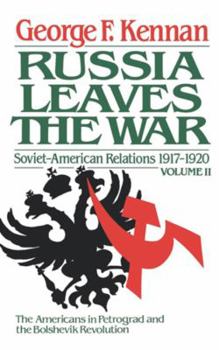The Decision to Intervene: Soviet-American Relations, 1917-1920
(Book #2 in the Soviet-American Relations Series)
Select Format
Select Condition 
Book Overview
In 1918 the U.S. government decided to involve itself with the Russian Revolution by sending troops to Siberia. This book re-creates that unhappily memorable storythe arrival of British marines at... This description may be from another edition of this product.
Format:Paperback
Language:English
ISBN:0393302172
ISBN13:9780393302172
Release Date:August 1984
Publisher:W. W. Norton & Company
Length:540 Pages
Weight:1.10 lbs.
Dimensions:1.2" x 5.0" x 8.0"
Customer Reviews
2 ratings
Indecision Instead of Decision
Published by Thriftbooks.com User , 19 years ago
The Decision to Intervene by George F. Kennan is Volume II of his History of Soviet-American Relations, 1917-1920. (See my review of Volume I, Russia Leaves the War.) The Decision to Intervene picks up in early 1918. The Bolsheviks had overthrown the democratically-oriented Provisional Government of Russia which came to power in February 1917 and had negotiated a separate truce with the Germans, taking Russia out of WWI. The details of a formal Russian-German peace treaty were undergoing tortuous negotiations at Brest-Litovsk. In the course of the war, Russia's allies, Britain, France, Italy, and, later, the US and Japan, had supplied significant quantities of strategic raw materials, arms, and munitions to Russia. Large stockpiles were still present at Vladivostok in the Far East and Archangel in the far northwest. Fearing that these strategic materials might be seized by or transferred to the Germans, the French, British and Italians favored landing allied troops to safeguard them. The Japanese supported this position, provided that they could unilaterally land their troops in Vladivostok, with American blessing, to create a bridgehead into Manchuria and Siberia. At this time there was also allied great concern that large numbers of German troops would be transferred from the eastern to the western front for a major offensive. By introducing some allied troops into Russia, the allies hoped to tie down an even larger number of German forces who might otherwise be sent west. For roughly the first half of 1918, President Wilson opposed intervention, and this opposition was sufficient to deter the allies. Around May of 1918, Raymond Robins, whom we met in Volume I as head of the American Red Cross mission to Russia and our informal point of contact with the Bolsheviks, was withdrawn from Russia. His self-appointed role as advocate of recognition of and aid to the Bolsheviks had come to naught, though he did not realize it for some months to come. At almost the same time as Robins departure, the Czechoslovak Legion in Russia was attacked by Red Guards. Czechoslovakia was then part of the Austrian Empire but its population dreamed of independence. The Czech Legion, about 30,000 well trained troops, fought against the Germans and Austrians alongside the Russian Army until Russia left the war. The Czechs had no intention of making peace with the Germans and Austrians but could not continue fighting on Russian territory. Consequently, they attempted to make their way east to Vladivostok from which point they hoped the allies would provide sea transport to the western front. The Bolsheviks, perhaps in response to German pressure, demanded that the Czechs surrender most of their arms and repeatedly delayed their passage along the Trans-Siberian Railway. When the Czechs refused to disarm, Red Guards ambushed them at Irkutsk. The Czechs fought back quite effectively, eventually captured the Trans-Siberian Railway all the way from Vladivostok to the U
Any serious history student needs this book.
Published by Thriftbooks.com User , 25 years ago
Since I am intensely interested in the subject of the American involvement in the intervention of North Russia just after the First World War (where the U.S. 339th Infantry fought against the 6th Red Army), I have a good many books on the subject, from "Fighting the Bolsheviki" to the more recent "Stillborn Crusade," and I have notes I made while researching original documents at the U.S. Library of Congress. But when I want to think in broader terms, I always pull out my copy of "The Decision to Intervene." It allows me to review the general situation at the time, including the activities of the Red Cross (who put the "Red" in the "Red Cross" Ha! Ha!), the U.S. troops in Siberia, and the Czechslovak situation at the time. I would be lost without this book. I highly recommend it!





